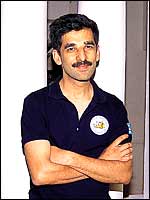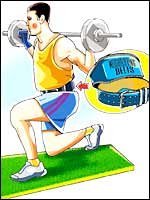 |
| WHOI's Singh: A man of many parts |
|
|
Hanumant
Singh went to the us to become a computer jock. Nothing unusual
about that; thousands of Indians follow the same course every
year. Except that Singh's conventional story takes a twist; he
did do his computer engineering, but then went on to do PhD in
oceanographic engineering.
How do you define an ocean engineer? Singh,
who is in his mid-30s, is a bit of everything, part biologist,
part seismologist, part electronics engineer, part marine archaeologist
and part geologist. He works with underwater vehicles and robots
to study oceans and their impact on our lives. Ask him how he
got interested in oceans, coming as he does from Chandigarh, which
is miles away from any ocean, and Singh quips: "It has a
lake."
As an assistant scientist at the Woods Hole
Oceanographic Institution (WHOI), Massachusetts, Singh is at present
writing a proposal to carry out research in the Bay of Bengal.
"The Andaman and Nicobar islands are among the most seismologically-active
regions in the world. It would be interesting as well as prudent
to mount an expedition there, particularly in the wake of the
tsunami last year," he says. It will be no easy task as the
Bay of Bengal is heavily sedimented, making it difficult to study
and map features on the ocean floor. If things go to plan, the
project should be on next year.
Singh is in India to gather some information
for his proposal, and visit family and friends in Chandigarh.
He did his schooling there at St Johns. After one year at Punjab
Engineering College, he moved to the US to study computer engineering
at George Mason University. How he ended up in WHOI, which is
an independent marine research and engineering organisation, is
another story.
"I was your typical broke student, looking
for work to make some extra money, and I saw this ad from WHOI.
Strangely enough, they were looking for someone who could write
computer code, which is what I did." That was in 1989.
He talks about how he and his team design
and use autonomous underwater vehicles and robots to map and take
images of ancient shipwrecks, hydrothermal vents and coral reefs,
and unravel other mysteries of ocean science. Recently, he and
his team pictured an amazingly healthy deep-water coral reef off
Puerto Rico.
Incidentally, a team from the institute led
by scientist Bob Ballard had discovered the wreck of the Titanic.
While it is pivotal work, Singh thinks it also overshadows the
other relevant work that the institute does. "The Titanic
sank, let's get over it," he says. He would like to talk
about hydrothermal vents, which are like geysers on the ocean
floor and support a thriving ecosystem. Scientists believe that
hydrothermal vents beneath the ice-covered Arctic Ocean could
provide clues to the origin of life on this planet.
Singh also feels that space science is overrated.
"Every shuttle expedition costs about $500 million (Rs 2,200
crore). We can only dream of such budgets. The human race knows
more about the dark side of the moon than we know about the bottom
of the seas."
Singh should know; exploring the deepest
parts of the ocean is his mission. The other thing he wants to
do is complete a marathon in under three hours. He took part in
the Boston Marathon in 1994. "The last six miles are the
killer," he says. You see, they aren't underwater.
-Kushan Mitra
TREADMILL
BELT-TIGHTENING TIME
The
new gym I'm going to is a plush, glass-and-chrome affair with
state-of-the-art equipment, polished trainers and smart spot-boys.
The members are all spandexed and brand-tagged. Everyone smells
nice; they smile at each other and make polite small-talk. Quite
a change from the gyms I've been used to where sweaty, smelly
muscle-bound lifters groan, yell and shout profanities all the
time. The other thing I noticed is the number of accessories people
carry: training gloves, arm-bands, knee-caps and lifting belts.
It's these last mentioned items that I'd like to draw attention
to. Lifting belts.
Time was when lifting belts were worn by
uber-huge powerlifters, snatching and jerking their way to medals
at the Olympics or other athletic events. Now, however, every
serious gym goer seems to carry one. I've seen grown men lift
puny five-pound dumb-bells wearing belts or do weight-free squats
with the said items strapped around their waists. Does it matter?
Do lifting belts help?
Lifting belts support the lower back when
you are lifting heavy weights while standing on your feet-think
weighted squats, dead-lifts, even overhead lifts like upright
military presses for the shoulders. Belts help reduce stress on
the lower back by pressing down on your abdominal cavity, thereby
providing support from the front.
When worn, lifting belts have to be tight
around the waist but loosened immediately after doing each set
of an exercise. This is because a very tight belt can push up
your blood pressure. Thus, if you're doing squats, tighten the
belt during the set but loosen it immediately afterwards.
Belts are of no use in exercises that do
not put pressure on your spinal erectors (muscles that hold up
the lower back), or involve lifting light to moderate weights.
Always check with a trainer or a physiotherapist (yes, my new
gym has a resident physiotherapist!) whether you should wear a
belt or not, particularly if you plan to lift heavy weights.
Caveat: The physical exercises described
in Treadmill are not recommendations. Readers should exercise
caution and consult a physician before attempting to follow any
of these.
-Muscles
Mani
write to musclesmani@intoday.com
KNOW
YOUR ARRHYTHMIAS
When
pop-science dispensers speak of killing-stress, they are referring
to arrhythmia (pronounced a-rhythm-ea). Stress isn't the only
cause (although it may be the most common). A lowdown:
What: The heart has a natural pacesetter,
the sinus node, a cluster of cells in the right atrium responsible
for maintaining a steady 60 to 90 heartbeats a minute. When something
goes wrong with this mechanism, it causes an increase in heartbeat
rate and, subsequently, chest pain, dizziness and light-headedness.
In extreme cases the cells in the sinus node could turn malignant.
The cause: Unknown. However, according
to Dr K. Subramanyam, Cardiologist, Escorts Heart Institute and
Research Centre, arrhythmias may be caused by anything from excessive
smoking and intake of alcohol to stress to diabetes.
Symptoms: Increase in heartbeat rate,
palpitation, chest pain, dizziness, lightheadedness, fainting.
Cure: In the early stages, temperance
helps. If malignant, the affected cells have to be killed by radio
frequency waves, a process called ablation. Our advice: Just slow
down a bit.
-Indrani Rajkhowa
|





